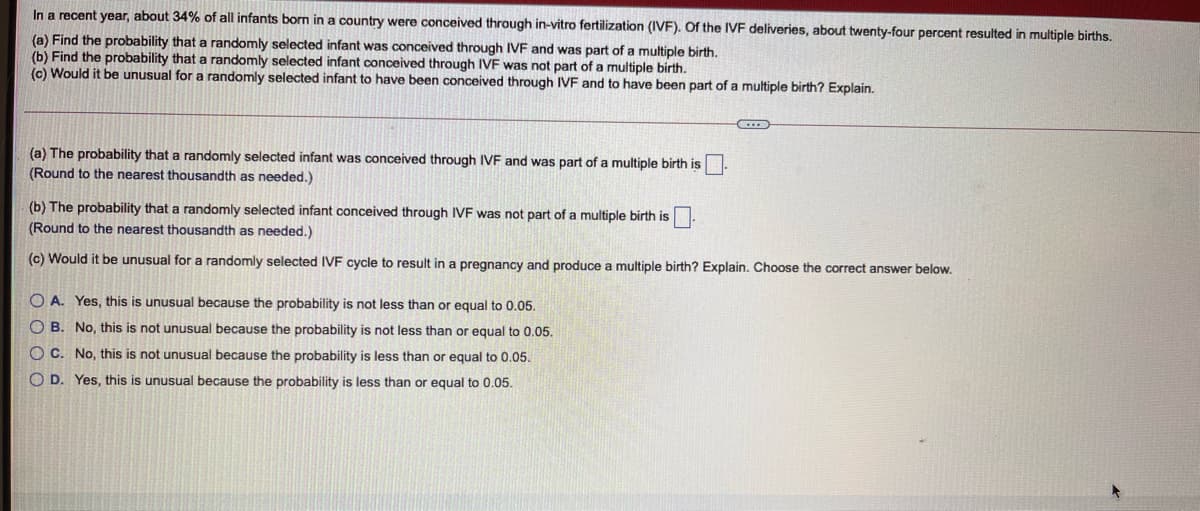In a recent year, about 34% of all infants born in a country were conceived through in-vitro fertilization (IVF). Of the IVF deliveries, about twenty-four percent resulted in multiple births. (a) Find the probability that a randomly selected infant was conceived through IVF and was part of a multiple birth. (b) Find the probability that a randomly selected infant conceived through IVF was not part of a multiple birth. (c) Would it be unusual for a randomly selected infant to have been conceived through IVF and to have been part of a multiple birth? Explain. (a) The probability that a randomly selected infant was conceived through IVF and was part of a multiple birth is (Round to the nearest thousandth as needed.) (b) The probability that a randomly selected infant conceived through IVF was not part of a multiple birth is. (Round to the nearest thousandth as needed.) (c) Would it be unusual for a randomly selected IVF cycle to result in a pregnancy and produce a multiple birth? Explain. Choose the correct answer below. O A. Yes, this is unusual because the probability is not less than or equal to 0.05. O B. No, this is not unusual because the probability is not less than or equal to 0.05. O C. No, this is not unusual because the probability is less than or equal to 0.05. O D. Yes, this is unusual because the probability is less than or equal to 0.05.
In a recent year, about 34% of all infants born in a country were conceived through in-vitro fertilization (IVF). Of the IVF deliveries, about twenty-four percent resulted in multiple births. (a) Find the probability that a randomly selected infant was conceived through IVF and was part of a multiple birth. (b) Find the probability that a randomly selected infant conceived through IVF was not part of a multiple birth. (c) Would it be unusual for a randomly selected infant to have been conceived through IVF and to have been part of a multiple birth? Explain. (a) The probability that a randomly selected infant was conceived through IVF and was part of a multiple birth is (Round to the nearest thousandth as needed.) (b) The probability that a randomly selected infant conceived through IVF was not part of a multiple birth is. (Round to the nearest thousandth as needed.) (c) Would it be unusual for a randomly selected IVF cycle to result in a pregnancy and produce a multiple birth? Explain. Choose the correct answer below. O A. Yes, this is unusual because the probability is not less than or equal to 0.05. O B. No, this is not unusual because the probability is not less than or equal to 0.05. O C. No, this is not unusual because the probability is less than or equal to 0.05. O D. Yes, this is unusual because the probability is less than or equal to 0.05.
Holt Mcdougal Larson Pre-algebra: Student Edition 2012
1st Edition
ISBN:9780547587776
Author:HOLT MCDOUGAL
Publisher:HOLT MCDOUGAL
Chapter11: Data Analysis And Probability
Section11.8: Probabilities Of Disjoint And Overlapping Events
Problem 2C
Related questions
Question

Transcribed Image Text:In a recent year, about 34% of all infants born in a country were conceived through in-vitro fertilization (IVF). Of the IVF deliveries, about twenty-four percent resulted in multiple births.
(a) Find the probability that a randomly selected infant was conceived through IVF and was part of a multiple birth.
(b) Find the probability that a randomly selected infant conceived through IVF was not part of a multiple birth.
(c) Would it be unusual for a randomly selected infant to have been conceived through IVF and to have been part of a multiple birth? Explain.
(a) The probability that a randomly selected infant was conceived through IVF and was part of a multiple birth is
(Round to the nearest thousandth as needed.)
(b) The probability that a randomly selected infant conceived through IVF was not part of a multiple birth is
(Round to the nearest thousandth as needed.)
(c) Would it be unusual for a randomly selected IVF cycle to result in a pregnancy and produce a multiple birth? Explain. Choose the correct answer below.
O A. Yes, this is unusual because the probability is not less than or equal to 0.05.
O B. No, this is not unusual because the probability is not less than or equal to 0.05.
O C. No, this is not unusual because the probability is less than or equal to 0.05.
O D. Yes, this is unusual because the probability is less than or equal to 0.05.
Expert Solution
This question has been solved!
Explore an expertly crafted, step-by-step solution for a thorough understanding of key concepts.
This is a popular solution!
Trending now
This is a popular solution!
Step by step
Solved in 2 steps

Recommended textbooks for you

Holt Mcdougal Larson Pre-algebra: Student Edition…
Algebra
ISBN:
9780547587776
Author:
HOLT MCDOUGAL
Publisher:
HOLT MCDOUGAL


Holt Mcdougal Larson Pre-algebra: Student Edition…
Algebra
ISBN:
9780547587776
Author:
HOLT MCDOUGAL
Publisher:
HOLT MCDOUGAL
